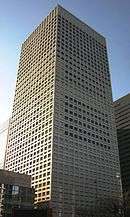KDDI
 | |
| Public (K.K.) | |
| Traded as | TYO: 9433 |
| Industry | Telecommunications |
| Founded | June 1, 1984 |
| Founder | Kazuo Inamori |
| Headquarters | Chiyoda, Tokyo, Japan |
Key people | Takashi Tanaka, CEO |
| Products | Fixed line and mobile telephony, Internet services, digital television |
| Revenue |
|
|
| |
Number of employees | 18,418 (2010)[1] |
| Parent |
Kyocera (12.76%) Toyota (11.09%) |
| Subsidiaries |
KDDI R&D Labs KDDI Network & Solutions Kokusai Cable Ship Okinawa Cellular Telephone KDDI America KDDI Global |
| Website | www.kddi.com |
KDDI Corporation (KDDI株式会社 KDDI Kabushiki Gaisha) (TYO: 9433) is a Japanese telecommunications operator formed in October 1, 2000 through the merger of DDI Corp. (Daini-Denden Inc.), KDD (Kokusai Denshin Denwa) Corp., and IDO Corp.[2] It has its headquarters in the Garden Air Tower in Iidabashi, Chiyoda, Tokyo.[3]
KDDI provides mobile cellular services using the "au by KDDI" brand. ISP network and solution services are provided under the au one net brand, while "au Hikari" is the name under which long-distance and international voice and data communications services and Fiber to the Home (FTTH) services are marketed. ADSL broadband services carry the brand name "ADSL One", and IP telephony over copper is branded as "Metal Plus".
History

On April 1, 2002, au by KDDI launched 3G networks using CDMA2000 1x technology.
On November 28, 2003, au by KDDI launched EV-DO Rev 0 service in the "CDMA 1X WIN" brand, and revolutionized Japan's mobile telecommunication industry by introducing fixed rate data subscription plans at a data rate of 2.4 Mbit/s.
On December 2006, au by KDDI became the first carrier to provide an EV-DO Rev A service at a data rate of 3.1Mbit/s (downlink), 1.8Mbit/s (uplink).
au by KDDI has been very successful with its EZ wireless data services, EZweb, EZweb@mail, EZappli, EZchakuuta, ezmovie, and EZnaviwalk (GPS), using the advanced WAP technology. It supports both Java ME and BREW application environments.
In November 2004 au by KDDI introduced the music include ringtone download service Chaku Uta Full (music ringtone full), for download of full length songs to mobile phones. Within six months from introduction, on June 15, 2005, customers had downloaded 10 million full length Chaku Uta Full songs.
As of end of June 2005, au by KDDI has 20,122,700 customers, among which 18,723,200 (93%) are 3G CDMA2000 subscribers. It is Japan's second-largest cellular operator with an increasing 20.0% market share.
On January 26, 2006, the first pointing local search application, Mapion Local Search - Powered by GeoVector, was launched on the KDDI network on their GPS and compass equipped handsets.[4] KDDI announced that it will collaborate with the Taiwanese manufacturer HTC Corp. to sell the mobile phone HTC J in Japan starting May 2012. The HTC J mobile phone will feature the Android 4.0 operating system.[5][6]
On October 21, 2011 KDDI buys Content Delivery Network CDNetworks For $167 Million.[7]
KDDI together with Sumitomo Group signed an agreement with Myanmar State owned Myanmar Post and Telecommunication (MPT) in July 2014 to jointly operate a mobile phone service in Myanmar for next 10 years.[8][9]
Consumer showroom is set in Harajuku called, "KDDI Designing Studio".
TU-KA (TU-KA by KDDI), a subsidiary company of KDDI, was a 2G PDC cellular operator in three metropolitan areas (Tokyo, Nagoya, and Osaka), which did not apply a 3G license. TU-KA was best known for having singer Ayumi Hamasaki to appear in their commercials. TU-KA was closed on March 31, 2008.
DDI Pocket, a PHS operator, was previously owned by KDDI but has now been spun off as Willcom.
In August 2014, KDDI announced it was joining forces with five other global companies, including Google to build a super-fast undersea data transmission cable linking the United States West Coast and Japan. The pipeline was expected to be completed by 2016-end.[10]
KDDI and Ericsson began working together in December 2015 in order to research and develop 5G technology.[11]
Lawsuits
In 2003, several class action complaints were filed against DDI for misrepresenting and/or failing to disclose material facts about the Company's financial results.[12] The parties agreed on a $4.4 million settlement in 2006.[13]
See also
- au
- KDDI Mobile
- G-Book, a telematics service provided by Toyota in Japan only
- KDDI India Private Limited
References and footnotes
- 1 2 3 "2015 Form 10-K, KDDI". Forbes.
- ↑ Merger of DDI, KDD and IDO
- ↑ "Corporate Data." KDDI. Retrieved on February 12, 2016.
- ↑ "Archived copy". Archived from the original on January 16, 2009. Retrieved April 22, 2009.
- ↑ "Brightwire". Brightwire. Retrieved 2016-03-28.
- ↑ "HTC and KDDI to sell HTC J". BrightWire.
- ↑ "Japanese Telco KDDI Buys Content Delivery Network CDNetworks For $167 Million". Techcrunch. October 21, 2011.
- ↑ "KDDI, Sumitomo ink deal with Myanmar telecom for mobile phone service (17 July 2014)". http://english.kyodonews.jp. Kyodo News. Retrieved 17 July 2014. External link in
|website=(help) - ↑ "KDDI, Sumitomo ink deal with Myanmar telecom for mobile phone service". http://www.japantimes.co.jp. The Japan Times. Retrieved 17 July 2014. External link in
|website=(help) - ↑ "High-speed Undersea Cable to Link US, Asia". The Tokyo News.Net. 12 August 2014. Retrieved 13 August 2014.
- ↑ Dan Kobialka (2015-12-01). "Ericsson, KDDI Partner for 5G Research and Development". Telco Hub content from Talkin' Cloud. Talkincloud.com. Retrieved 2016-03-28.
- ↑ "Class action suit filed vs DDI".
- ↑ http://securities.stanford.edu/1028/DDICQOB03-01//. Missing or empty
|title=(help)
External links
| Wikimedia Commons has media related to KDDI. |
- (Japanese) KDDI CORPORATION
- (English) KDDI CORPORATION
- (English) Global - KDDI CORPORATION
- KDDI au